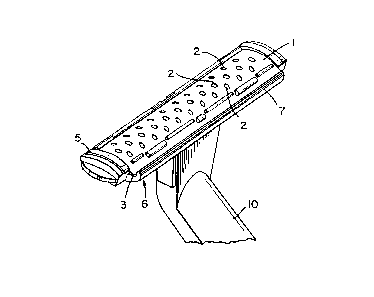Some of the information on this Web page has been provided by external sources. The Government of Canada is not responsible for the accuracy, reliability or currency of the information supplied by external sources. Users wishing to rely upon this information should consult directly with the source of the information. Content provided by external sources is not subject to official languages, privacy and accessibility requirements.
Any discrepancies in the text and image of the Claims and Abstract are due to differing posting times. Text of the Claims and Abstract are posted:
| (12) Patent: | (11) CA 2037895 |
|---|---|
| (54) English Title: | SAFETY RAZORS |
| (54) French Title: | RASOIRS DE SURETE |
| Status: | Expired and beyond the Period of Reversal |
| (51) International Patent Classification (IPC): |
|
|---|---|
| (72) Inventors : |
|
| (73) Owners : |
|
| (71) Applicants : |
|
| (74) Agent: | MACRAE & CO. |
| (74) Associate agent: | |
| (45) Issued: | 1998-07-07 |
| (86) PCT Filing Date: | 1990-07-10 |
| (87) Open to Public Inspection: | 1991-01-25 |
| Examination requested: | 1993-11-17 |
| Availability of licence: | N/A |
| Dedicated to the Public: | N/A |
| (25) Language of filing: | English |
| Patent Cooperation Treaty (PCT): | Yes |
|---|---|
| (86) PCT Filing Number: | PCT/US1990/003863 |
| (87) International Publication Number: | WO 1991001204 |
| (85) National Entry: | 1991-03-25 |
| (30) Application Priority Data: | ||||||
|---|---|---|---|---|---|---|
|
A safety razor in which the blade (1) has a plurality of sharp-edge apertures (2) for shaving and also a sharpened rectilinear
edge (3) for trimming. Provision is made for effecting displacement of the blade relative to the razor handle (10) so that the
trimming edge which is normally in an inoperative position can be moved into an operative position. The blade is held in an
arched position so that the aforesaid movement is of a rocking nature.
Rasoir de sûreté dont la lame (1) comporte une pluralité d'ouvertures (2) à bord tranchant pour effectuer le rasage, ainsi qu'un bord rectiligne (3) pour effectuer les coupes droites. Un mécanisme permet le mouvement de la lame par rapport au manche (10) du rasoir, afin que le bord rectiligne puisse passer d'une position normalement inopérante à une position opérante. La lame est maintenue dans une position arquée, ce autorise le mouvement basculant mentionné ci-dessus.
Note: Claims are shown in the official language in which they were submitted.
Note: Descriptions are shown in the official language in which they were submitted.

2024-08-01:As part of the Next Generation Patents (NGP) transition, the Canadian Patents Database (CPD) now contains a more detailed Event History, which replicates the Event Log of our new back-office solution.
Please note that "Inactive:" events refers to events no longer in use in our new back-office solution.
For a clearer understanding of the status of the application/patent presented on this page, the site Disclaimer , as well as the definitions for Patent , Event History , Maintenance Fee and Payment History should be consulted.
| Description | Date |
|---|---|
| Inactive: IPC from MCD | 2006-03-11 |
| Inactive: IPC from MCD | 2006-03-11 |
| Time Limit for Reversal Expired | 2000-07-10 |
| Letter Sent | 1999-07-12 |
| Grant by Issuance | 1998-07-07 |
| Inactive: Final fee received | 1998-03-23 |
| Pre-grant | 1998-03-23 |
| Inactive: Received pages at allowance | 1998-03-23 |
| Notice of Allowance is Issued | 1997-09-24 |
| Notice of Allowance is Issued | 1997-09-24 |
| Letter Sent | 1997-09-24 |
| Inactive: Status info is complete as of Log entry date | 1997-09-22 |
| Inactive: Application prosecuted on TS as of Log entry date | 1997-09-22 |
| Inactive: IPC removed | 1997-08-12 |
| Inactive: First IPC assigned | 1997-08-12 |
| Inactive: IPC assigned | 1997-08-12 |
| Inactive: Approved for allowance (AFA) | 1997-08-11 |
| All Requirements for Examination Determined Compliant | 1993-11-17 |
| Request for Examination Requirements Determined Compliant | 1993-11-17 |
| Application Published (Open to Public Inspection) | 1991-01-25 |
There is no abandonment history.
The last payment was received on 1998-06-26
Note : If the full payment has not been received on or before the date indicated, a further fee may be required which may be one of the following
Please refer to the CIPO Patent Fees web page to see all current fee amounts.
| Fee Type | Anniversary Year | Due Date | Paid Date |
|---|---|---|---|
| MF (application, 7th anniv.) - standard | 07 | 1997-07-10 | 1997-06-30 |
| Final fee - standard | 1998-03-23 | ||
| MF (application, 8th anniv.) - standard | 08 | 1998-07-10 | 1998-06-26 |
Note: Records showing the ownership history in alphabetical order.
| Current Owners on Record |
|---|
| THE GILLETTE COMPANY |
| Past Owners on Record |
|---|
| DAVID JOHN WILKES |
| FRANK EDWARD BROWN |
| JOHN TAYLOR |